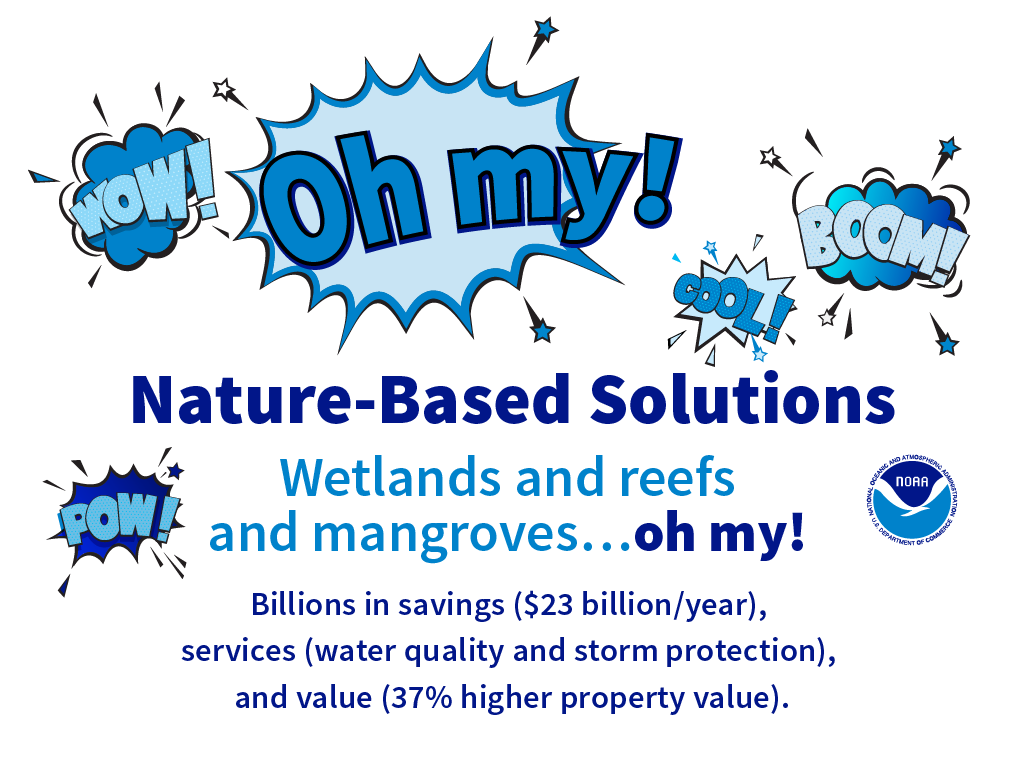Fast Facts / Natural Infrastructure
Natural Infrastructure
Nature provides effective solutions for minimizing coastal flooding, erosion, and runoff, as do man-made systems that mimic natural processes—known as natural infrastructure. Examples include mangroves and wetlands, oyster reefs, and sand dunes; permeable pavement and driveways; green roofs; and natural areas incorporated into city designs. A natural infrastructure approach represents a successful and cost efficient way to protect coastal communities.
$23.2 Billion in Storm Protection
Coastal wetlands in the U.S. are estimated to provide $23.2 billion in storm protection services every year.1
$7 Saved for every $1 spent
Wetland and reef restoration in the Gulf of Mexico can yield benefit-to-cost ratios greater than seven to one—or seven dollars in flood-reduction benefits for every dollar spent on restoration.2
$99,000 Worth of Services
Approximately 2.5 acres of restored or protected oyster reefs can provide up to $99,000 worth of services every year. In addition to shoreline stabilization, these reefs improve water quality.3
Saving Money, Lives, and Property
Conserving and restoring oyster reefs, wetlands, and mangroves can prevent flooding and save hundreds of millions of dollars in storm damage. Wetlands reduced damages by more than 22 percent in half of the areas affected by Hurricane Sandy, and by as much as 30 percent in some states.4
Living Shorelines Rock!
This stabilization technique relies on natural materials—often a combination of oyster reefs, sand, and vegetation. The living shoreline approach can keep pace with sea level rise, and can be cheaper to build and maintain than gray infrastructure. Added benefits: improved water and air quality; can store carbon dioxide; and can self-maintain, self-repair, and self-recover.5
Powerful Protection
Oyster reefs and marshes act as natural barriers to waves; 15 feet of marsh can absorb up to 50 percent of incoming wave energy.6
Solutions Worth Billions
Natural infrastructure solutions could help avert more that 45 percent of the climate risk in the Gulf of Mexico over a 20-year period, saving the region over $50 billion in flood damages.2
Growing Trees Grows Value
Residential property values can increase by up to 37 percent due to the presence of trees and vegetation. Trees and vegetation also absorb and clean water, reducing flooding and pollution impacts and saving communities money on stormwater infrastructure.1
Leading by Example
Natural infrastructure projects around the country have proven effective. Examples include the following:
- Mobile Bay, Alabama: Two soon-to-be implemented oyster reef restoration projects should reduce wave height by 51 to 90 percent and reduce wave energy at the shore by 76 to 99 percent. The reef construction is anticipated to add $8.4 million to the local economy.7
- Muskegon Lake, Michigan: Studies say a wetland restoration and shoreline stabilization project for the lake should power up the local economy by more than $57 million, boosting property values by $12 million, bringing $600,000 extra in yearly tax revenues, and providing an extra $1 million annually in recreational spending.
- Clear Lake, Texas: A 200-acre reclaimed urban wetland—formerly an abandoned golf course—acted as a sponge during Hurricane Harvey, protecting residents and their homes from potentially deadly flooding.8
- Aurora, Illinois: 28 rain gardens were installed at intersections in a storm sewer area in 2013, which saved the city an estimated $1.8 million.7
- Chicago, Illinois: Implementation of green roofs and permeable pavement has provided the city the capacity to capture over 85 million gallons of stormwater each year.7


Handout: Top Ten Natural Infrastructure
Source: The Center for Clean Air Policy
1: The Value of Green Infrastructure for Urban Climate Adaptation
Source: PLOS ONE Research Article
2: Comparing the Cost Effectiveness of Nature-based and Coastal Adaptation
Source: American Institute of Biological Sciences
3: Economic Valuation of Ecosystem Services Provided by Oyster Reefs
Source: NOAA
4: Why is Natural Infrastructure Important?
5: NOAA Study
7: Green Infrastructure Effectiveness Database
8: Urban Golf Course-Turned-Wetland Cuts Hurricane Harvey Flood Impacts